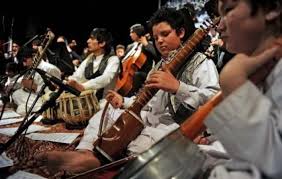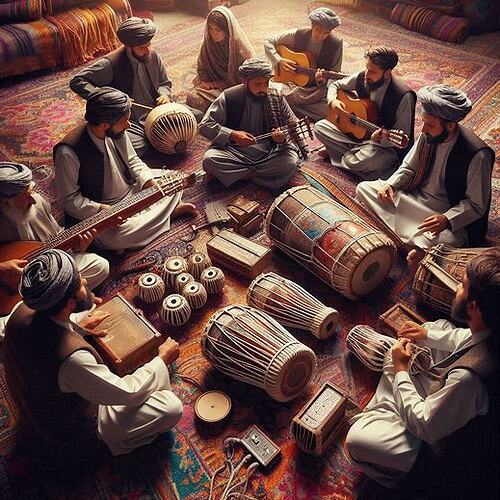Folk music in Afghanistan
Afghanistan has a very rich cultural diversity, which is also well visible in its local music. The folk music of Afghanistan has attracted influences from the history, different ethnic cultures and geographical diversity of this country. Below we will mention some local music styles in Afghanistan:
-
Pashtun music: The Pashtun people, who are one of the largest ethnic groups in Afghanistan, have a very rich musical heritage. Pashtun music includes different styles such as “rababi” (which is a type of rebab instrument), “santoori” (centaur instrument) and “tamboori” (tambour instrument). These styles are usually performed with Pashtun poetry and songs and have deep emotions and storytelling.
-
Hazara music: The Hazara people, who are another main ethnic group in Afghanistan, also have a local music style that includes instruments such as “rabab” and “dhol” (a type of drum). Hazara music is usually performed with local songs and poems and is inspired by the values and cultural heritage of this people.
-
Hazarjeti music: The Hazarjeti people who live in the northern regions of Afghanistan have a special local music called “Doh”. This music is performed using local instruments such as “Doh” and “Daira” (a type of drum) and is mainly used in various local ceremonies and ethnic gatherings.
-
Nurstani music: In the Nuristan region, which is located in the northeast of Afghanistan, there is a special local music that includes the use of traditional instruments such as “Surnai” (wind instrument) and “Doh”. This style of music is well inspired by the culture and traditional life of this region.
This diversity in the folk music of Afghanistan shows the cultural wealth of this country and plays an important role in maintaining the identity and social connection of people.
With the arrival of the Taliban, what changes have come in local music in Afghanistan?
With the arrival of the Taliban and changes in the political and social atmosphere of Afghanistan, local music in this country has been affected and various changes may have occurred. As a group with strict Islamic views, the Taliban have a negative view of some cultural and artistic activities, including music. In this context, the following changes may have occurred in folk music in Afghanistan during the period of Taliban rule:
-
Prohibition of public music: The Taliban usually consider public music inappropriate and against Islamic principles and may ban public music. This action can lead to severe restrictions for performing and listening to local music in different communities.
-
Change in the cultural environment: The Taliban government usually promotes a completely Islamic cultural environment based on Islamic views, which may lead to a reduction in the space for traditional artistic and cultural activities.
-
Banning against some instruments: Some traditional local instruments in Afghanistan may be banned, because the Taliban often have a negative view of the instruments or musical performances that are used in them.
-
Impact on artists and musicians: Local artists and musicians may face problems and be pressured to limit or stop their activities.
-
Change in local music culture: Under the Taliban rule, local music may have changes in its theme, style or performance in order to adapt to the religious views of the Taliban.
In general, with the arrival of the Taliban, there have been so many changes in the cultural and artistic atmosphere of Afghanistan that may have led to changes in the country’s local music. These changes are highly dependent on the specific policies and actions of the Taliban government and the society’s reactions.
The development of local music during the republic
During the republic in Afghanistan, local music developed and developed as an important part of the culture and identity of the people of this country. In this period, with the increase of cultural and artistic awareness and the development of the cultural space, local music developed as one of the main pillars of Afghan art and was reflected in various forms. Below are some features and developments of local music during the Republic of Afghanistan:
-
Cultural promotion: During the republic, the Afghan government paid special attention to the promotion of local culture and arts, including local music. This promotion made the community more aware of its cultural heritage and provided a space for the development and strengthening of local music.
-
Influence on artists: During the Republic period, local artists and musicians had more opportunities to perform and publish their works. These facilities included providing funds for artistic activities, building organs and art halls, and promoting local music programs.
-
Infrastructure Development: During the Republic period, the infrastructure needed to perform local music, including concert halls, recording studios, and art schools, was developed so that artists could present their best performances and works. .
-
Local music in the media: During the republic period, local music was published more in different media of Afghanistan. This included broadcasting music on radio and television, producing local music albums, and promoting concerts and music festivals.
-
Supporting traditional arts: During the republic period, the government supported traditional arts and local music and tried to display these works and introduce them to different parts of Afghanistan and the world.
In general, during the period of the Republic of Afghanistan, local music developed as one of the important cultural and artistic symbols of this country and benefited from the positive effects of government support and an active cultural and artistic atmosphere.


